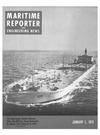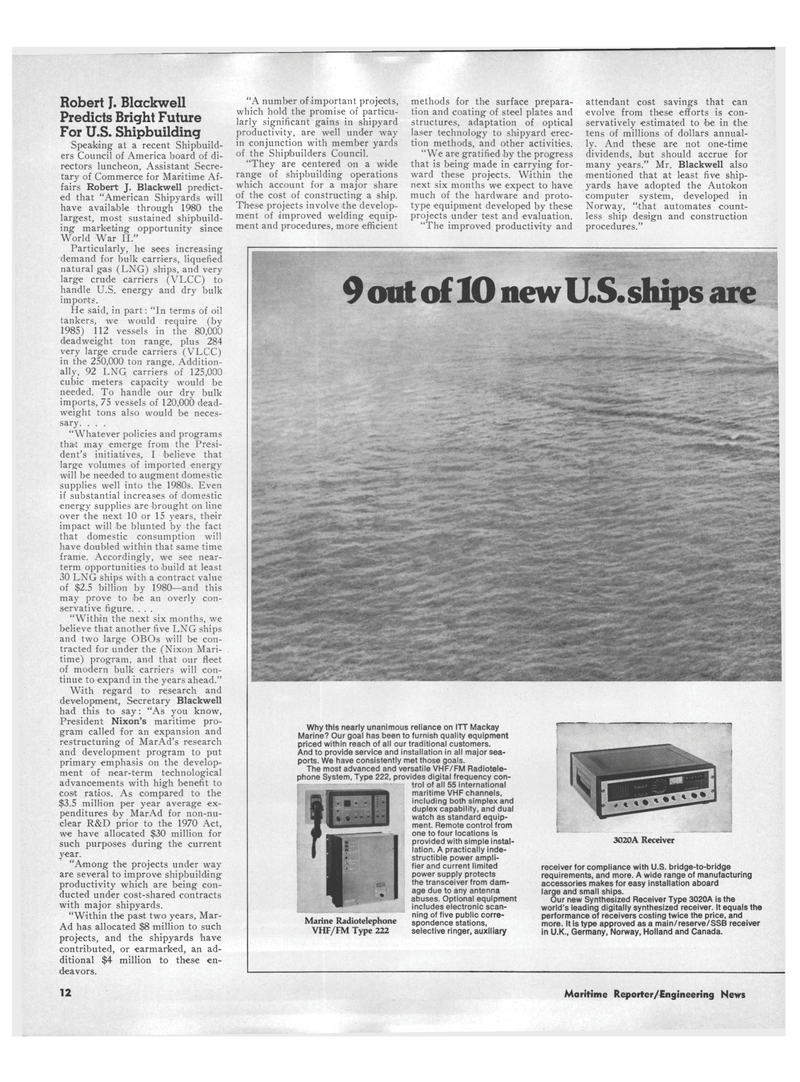
Page 10: of Maritime Reporter Magazine (January 1973)
Read this page in Pdf, Flash or Html5 edition of January 1973 Maritime Reporter Magazine
Robert J. Blackwell
Predicts Bright Future
For U.S. Shipbuilding
Speaking at a recent Shipbuild- ers Council of America board of di- rectors luncheon, Assistant Secre- tary of Commerce for Maritime Af- fairs Robert J. Blackwell predict- ed that "American Shipyards will have available through 1980 the largest, most sustained shipbuild- ing marketing opportunity since
World War II."
Particularly, he sees increasing demand for bulk carriers, liquefied natural gas (LNG) ships, and very large crude carriers (VLCC) to handle U.S. energy and dry bulk imports.
He said, in part: "In terms of oil tankers, we would require (by 1985) 112 vessels in the 80,000 deadweight ton range, plus 284 very large crude carriers (VLCC) in the 250,000 ton range. Addition- ally, 92 LNG carriers of 125,000 cubic meters capacity would be needed. To handle our dry bulk imports, 75 vessels of 120,000 dead- weight tons also would be neces- sary. . . . "Whatever policies and programs that may emerge from the Presi- dent's initiatives, I believe that large volumes of imported energy will be needed to augment domestic supplies well into the 1980s. Even if substantial increases of domestic energy supplies are brought on line over the next 10 or 15 years, their impact will be blunted by the fact that domestic consumption will have doubled within that same time frame. Accordingly, we see near- term opportunities to build at least 30 LNG ships with a contract value of $2.5 billion by 1980—and this may prove to be an overly con- servative figure. . . . "Within the next six months, we believe that another five LNG ships and two large OBOs will be con- tracted for under the (Nixon Mari- time) program, and that our fleet of modern bulk carriers will con- tinue to expand in the years ahead."
With regard to research and development, Secretary Blackwell had this to say: "As you know,
President Nixon's maritime pro- gram called for an expansion and restructuring of MarAd's research and development program to put primary emphasis on the develop- ment of near-term technological advancements with high benefit to coat ratios. As compared to the $3.5 million per year average ex- penditures by MarAd for non-nu- clear R&D prior to the 1970 Act, we have allocated $30 million for such purposes during the current year. "Among the projects under way are several to improve shipbuilding productivity which are being con- ducted under cost-shared contracts with major shipyards. "Within the past two years, Mar-
Ad has allocated $8 million to such projects, and the shipyards have contributed, or earmarked, an ad- ditional $4 million to these en- deavors. "A number of important projects, which hold the promise of particu- larly significant gains in shipyard productivity, are well under way in conjunction with member yards of the Shipbuilders Council. "They are centered on a wide range of shipbuilding operations which account for a major share of the cost of constructing a ship.
These projects involve the develop- ment of improved welding equip- ment and procedures, more efficient methods for the surface prepara- tion and coating of steel plates and structures, adaptation of optical laser technology to shipyard erec- tion methods, and other activities. "We are gratified by the progress that is being made in carrying for- ward these projects. Within the next six months we expect to have much of the hardware and proto- type equipment developed by these projects under test and evaluation. "The improved productivity and attendant cost savings that can evolve from these efforts is con- servatively estimated to be in the tens of millions of dollars annual- ly. And these are not one-time dividends, but should accrue for many years." Mr. Blackwell also mentioned that at least five ship- yards have adopted the Autokon computer system, developed in
Norway, "that automates count- less ship design and construction procedures." 9 out of 10 new U.S.ships are
Why this nearly unanimous reliance on ITT Mackay
Marine? Our goal has been to furnish quality equipment priced within reach of all our traditional customers.
And to provide service and installation in all major sea- ports. We have consistently met those goals.
The most advanced and versatile VHF/FM Radiotele- phone System, Type 222, provides digital frequency con- trol of all 55 international maritime VHF channels, including both simplex and duplex capability, and dual watch as standard equip- ment. Remote control from one to four locations is provided with simple instal- lation. A practically inde- structible power ampli- fier and current limited power supply protects the transceiver from dam- age due to any antenna abuses. Optional equipment includes electronic scan- ning of five public corre- spondence stations, selective ringer, auxiliary 3020A Receiver receiver for compliance with U.S. bridge-to-bridge requirements, and more. A wide range of manufacturing accessories makes for easy installation aboard large and small ships.
Our new Synthesized Receiver Type 3020A is the world's leading digitally synthesized receiver. It equals the performance of receivers costing twice the price, and more. It is type approved as a main/reserve/SSB receiver in U.K., Germany, Norway, Holland and Canada.
Marine Radiotelephone
VHF/FM Type 222 12 Maritime Reporter/Engineering News

 9
9

 11
11
